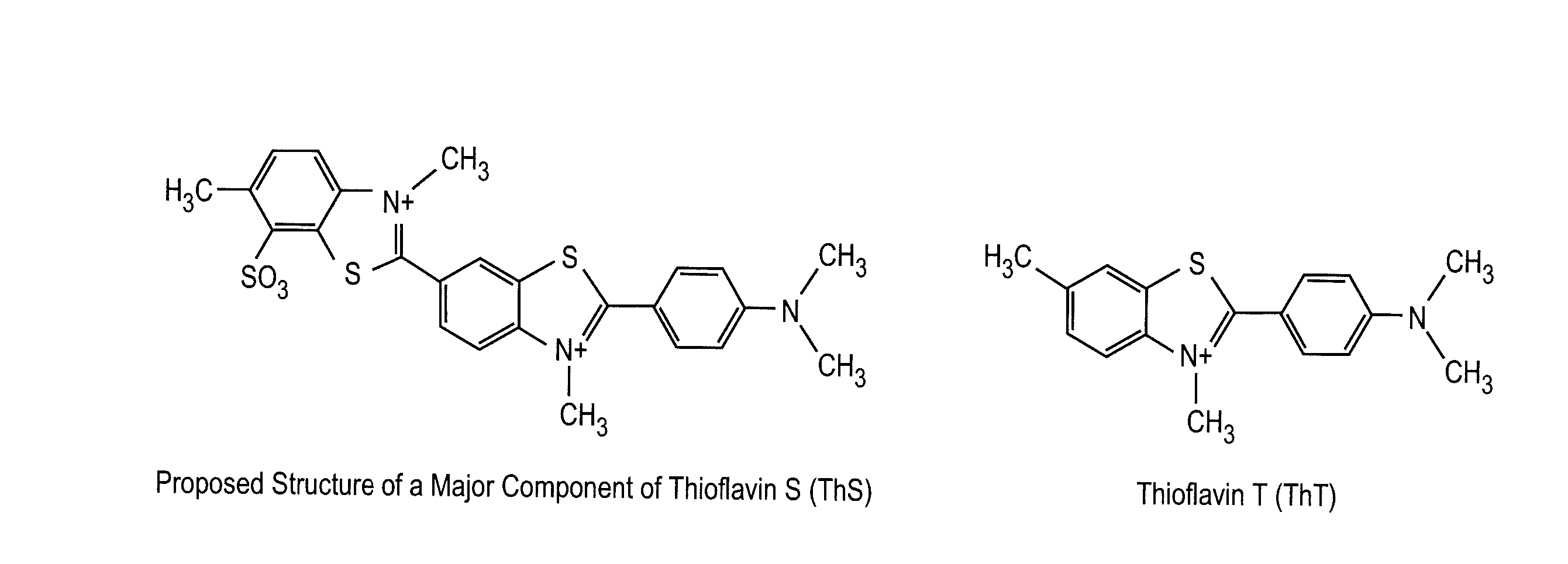Thioflavin derivatives for use in antemortem diagnosis of alzheimer's disease and in vivo imaging and prevention of amyloid deposition
a technology of thioflavin and derivatives, applied in the field of thioflavin derivatives, can solve the problems of inability to detect neuritic plaques, difficulty, and unknown time of onset, and achieve the effect of low toxicity
- Summary
- Abstract
- Description
- Claims
- Application Information
AI Technical Summary
Benefits of technology
Problems solved by technology
Method used
Image
Examples
examples
[0096] All of the reagents used in the synthesis were purchased from Aldrich Chemical Company and used without further purification. Melting points were determined on MeI-TEMP II and were uncorrected. The 1H NMR spectra of all compounds were measured on Bruker 300 using TMS as internal reference and were in agreement with the assigned structures. The TLC was performed using Silica Gel 60 F254 from EM Sciences and detected under UV lamp. Flash chromatography was performed on silica gel 60 (230-400 mesh purchased from Mallinckrodt Company. The reverse phase TLC were purchased from Whiteman Company.
synthesis examples
Example 1
Synthesis of 2-(4′-aminophenyl)-benzothiazole derivatives
[0097] Route 1: Example of the synthesis of 6-MeO-BTA-0, -1, -2, which are representative of the group of thioflavin compounds (Shi et al., “Antitumor Benzothiazoles. 3. Synthesis of 2-(4-Aminophenyl)benzothiazoles and Evaluation of Their Activities against Breast Cancer Cell Lines in Vitro and in Vivo”J. Med. Chem. 39:3375-3384, 1996) (reference numbers of the names compounds below refer to the synthetic scheme shown):
(a) 4-Methoxy-4′-nitrobenzanilide (3)
[0098] p-Anisidine 1 (1.0 g, 8.1 mmol) was dissolved in anhydrous pyridine (15 ml), 4-nitrobenzoyl chloride 2 (1.5 g, 8.1 mmol) was added. The reaction mixture was allowed to stand at room temperature for 16 hrs. The reaction mixture was poured into water and the precipitate was collected with filtrate under vacuum pressure and washed with 5% sodium bicarbonate(2×10 ml). The product 3 was used in the next step without further purification. 1HNMR (300 MHz, DMSO-d...
example 1
Determination of Affinity for Aβ and Brain Uptake of Thioflavin Derivatives
[0113] Initial competitive binding studies using [3H]CG and synthetic Aβ(1-40) were conducted to determine if CG, ThS and ThT bound to the same site(s). It has been determined that ThS competed with [3H]CG for binding sites on Aβ (1-40), but ThT did not (see, e.g., FIG. 5). High specific activity [N-methyl-11C]BTA-1 (see Table 1) was then synthesized by methylation of BTA-0. Bindings studies were performed with [N-methyl-11C]BTA-1 and 200 nM Aβ(1-40) fibrils. The specific binding of [N-methyl-11C]BTA-1 was ˜70%. FIG. 5 (see the right panel) shows competition curves for Aβ sites by ThT, BTA-0, BTA-1, and BTA-2 using the [N-methyl-11C]BTA-1 binding assay. The Ki's were: 3.0±0.8 nM for BTA-2; 9.6±1.8 nM for BTA-1; 100±16 nM for BTA-0; and 1900±510 nM for ThT. Not only is the quaternary amine of ThT not necessary for binding to Aβ fibrils, it appears to decrease binding affinity as well.
[0114] In Table 1 below ...
PUM
| Property | Measurement | Unit |
|---|---|---|
| dissociation constant | aaaaa | aaaaa |
| dissociation constant | aaaaa | aaaaa |
| partition coefficient | aaaaa | aaaaa |
Abstract
Description
Claims
Application Information
 Login to View More
Login to View More - R&D
- Intellectual Property
- Life Sciences
- Materials
- Tech Scout
- Unparalleled Data Quality
- Higher Quality Content
- 60% Fewer Hallucinations
Browse by: Latest US Patents, China's latest patents, Technical Efficacy Thesaurus, Application Domain, Technology Topic, Popular Technical Reports.
© 2025 PatSnap. All rights reserved.Legal|Privacy policy|Modern Slavery Act Transparency Statement|Sitemap|About US| Contact US: help@patsnap.com



